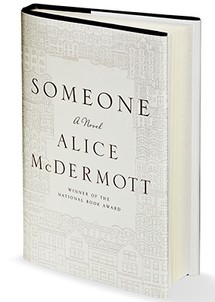Someone
By Alice McDermott
240 pages;
Farrar, Straus and Giroux
In her quietly magnificent new work of fiction, her first in
seven years, National Book Award winner Alice McDermott trains her masterly
microscope on a single, unremarkable woman and the Brooklyn neighborhood she
inhabits for nearly three decades. Someone opens with Marie, a homely 7-year-old wearing
Coke-bottle glasses, sitting on the steps of her family’s brownstone awaiting
her father’s return from work. From that perch, she observes the comings and
goings of her fellow Irish Catholic immigrants—groups of nuns in wimples
walking by, girls gossiping in the bright sunshine, boys playing stickball in
the street, their games refereed by a blind umpire. As the narrative
effortlessly weaves through time, Marie’s maturation is charted in richly
portrayed milestones: her failed attempts at baking soda bread with her mother,
her role as the “consoling angel” at Fagin’s funeral parlor. Her studious
brother, Gabe, is called to be a priest, then suddenly abandons his vocation
and his faith. Throughout the novel, the rhythmic undercurrents of life pulse
along—babies are born, neighbors die, their departures marked by wakes at Fagin’s,
women leave their parents’ homes to marry and the country goes to war again.
McDermott has the soul of an archaeologist—excavating shards of the daily
routine, closely examining the cracks and crevices of the human heart. A
lifetime, as seen through her eyes, is marked by moments both profound (the
deaths of Marie's parents and births of her four children) and seemingly
inconsequential (a comforting voice in a dark hospital room, the teakettle’s
whistle, the flame of a single candle). Through it all, “the ordinary, rushing
world [went] on, closing up over happiness as readily as it moved to heal
sorrow.”
— Abbe Wright


